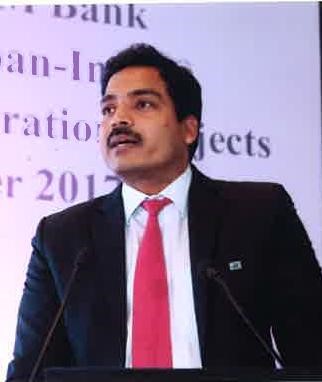IDBI Bank has just got out of the Reserve Bank of India's (RBI) prompt corrective action (PCA) list after feeling chained for almost four years.
In a candid interview with Indianbankingnews.com’s Editor Manju AB, IDBI Bank Deputy Managing Director Samuel Joseph talks about the legacy bad loans the bank is saddled with, the corrective steps taken and the need to be cautious regarding some sectors while lending.
Admitting that the bank's gross non-performing assets (NPAs) are still high, Joseph says recovery of bad loans is work in progress. He also talks about privatisation of the bank and the capital support provided by the Life Insurance Corporation (LIC) when the bank was in trouble.
The balance sheet was weighed down by legacy bad loans, which needed cleaning up. We began this exercise by identifying NPAs, which necessitated higher provisioning. As the capital position of the bank was weak, the government and the LIC pumped in about Rs 43,000 crore. This helped us make accelerated provisions and strengthen the balance sheet.
Following the provisions, the profits were impacted and that was when the bank started incurring huge losses. Even during the PCA period, which commenced from May 2017, the performance of the bank was steady as reflected in decent operating profit, but the losses were the spillover of provisioning. So that part of the balance sheet clean-up has been to a large extent done, now that we have had four quarters of profits.
Recovery of the NPAs is work in progress. We have been successful to some extent. Our write-off figure is not so huge as compared to other banks. That is why our gross NPAs are still very high. Usually banks do a technical write-off once they put in place 100% provisioning, and it goes off the balance sheet. Even after this write-off, the recovery efforts are on in full swing.
This creates problems from the tax angle as the losses move from DTA (deferred tax liability) on provisioning loss to business loss. There is no impact of write-off on the profit-and-loss account of the bank, since it is 100% provided. But the tax books get altered because the DTA on business loss has a limited period of eight years to reverse or set off, while DTA on provisions has an unlimited expiry period. Hence, we have not written off as aggressively as the others have done. We have been very conservative about writing off bad loans.
Our gross NPAs are still elevated at 23.52%. If we add the proforma NPAs, it will go up to 24.33%. But our net NPA is well under control at 1.94%. Even if you add the proforma NPAs, it will be still at 2.75%. If you compare our proforma NPAs versus what is with the rest of the industry, ours is about 0.85%, while for most other banks it is above 1%. For some, it is even higher at 1.5% of the total gross advances. This, coupled with our below-industry-average restructuring book, confirms that a major portion of the cleaning up and the strengthening of the balance sheet has already been achieved in our case.
What is work in progress is the recovery of the legacy NPAs. Our gross NPA book is about Rs 37,500 crore and the cumulative technical write-off which is outstanding in our books is about another Rs 40,000 crore. We will have to work towards recovering it.
Most of the NPAs are the large value corporates and a lot of them are stuck in the NCLT (National Company Law Tribunal). Almost Rs 45,000 crore of our NPAs are admitted into NCLT but yet to be resolved. Another Rs 17,000 crore is filed in the NCLT but is yet to be admitted. This is a substantive portion of our total NPAs. As and when they are resolved, we will be able to settle dues and recover the bad loans.
We are also actively pursuing assignment of debts through sale to the ARCs (asset reconstruction companies). One-time negotiated settlements are also being done wherever possible. After admission into NCLT, we can do one-time settlements only if 90% of the lenders agree. We have been taking a case-specific approach as to whether NCLT is the best option or whether it should be the last option after exploring restructuring, negotiated settlements or assignment of debts.
In the last three years, we have completely revamped our risk management policies. We have made it more granular and tightened the sanctioning processes. We have set internal sectoral limits and identified sectors where we have to be highly cautious in lending. We have higher onboarding thresholds for these highly cautious sectors. So a lot of work has happened internally which is not visible in the P&L as on date. If an industry is classified by the risk management department as highly cautious, we do not lend unless it has an ‘A’ rating and a minimum score as per the internal rating model which we have fixed. If it is lower than our set benchmark, it has to be escalated to a sanctioning committee at a higher level. This sort of tightening processes has been done based on our views of the sector.

It is a dynamic list which keeps changing, depending on how the risk management department views it. Suffice it to say that we have a classification of these industries and higher the risk perception, higher the threshold for onboarding the borrower.
We continue to be highly cautious about the infrastructure sectors like power, where we already have large exposures.
Some of the power accounts are in the NCLT. The consortium of lenders is trying to find resolutions outside the NCLT as well. In some cases, the resolution process gets long-drawn and the value of the assets gets destroyed.
We are hopeful that some recoveries will happen before the end of March. In Bhushan Power and Steel, where we are part of the consortium, we expect recovery of Rs 480 crore. This is 100% provided account in our books.
During the PCA period, there was no bar on the retail lending or the priority sector lending which the bank was undertaking. Even before the lifting of the PCA which happened this week, the RBI had granted us some interim relaxation, whereby we have been sanctioning 25% enhancement in limits or Rs 25 crore in existing accounts that are rated ‘A’ and above and in a limited way on-board new corporate customers as well. So, on the ground level there is not going to be much of a change now that we are out of the PCA. On the corporate side, though, we will have more room to lend than what the RBI relaxation allowed us to do. But it will be a gradual and calibrated process.
Though we had met the threshold limits to move out of the PCA based on March 2021 quarterly numbers, I think the regulator wanted to be sure how Covid-19 would impact our balance sheet. Now that the impact of Covid is clearer than it was at the beginning of this financial year, and our financial position has improved further due to consecutive profits in four quarters and also the QIP (qualified institutional placement) capital raising, the RBI might have been comfortable in taking us out of PCA. The Central Bank of India, UCO and Indian Overseas Bank are still under PCA.
At present, our retail-to-corporate advance book ratio is 60:40. We would like to keep this retail ratio at around 55-60%. When we say retail, it includes our structured retail asset, agri and MSME (micro, small & medium enterprises) lending. Over 60% of our retail assets are in structured retail assets and within that almost 94% is mortgage loans. This is reflected in the low delinquency ratio in our retail book.

We will evaluate each proposal on the basis of the merits in the case. Our decision will of course be tempered by our past learning.
The government has to take a call. Preparations may be happening in Delhi. We are not privy to that. Already we are called a private sector bank.
That is for the board of LIC to take a call. We do not have any say in that.
We have been reporting about the progress in sale of non-core assets, every quarter. Even in the previous quarter, we had reported about the 21% stake sale to the existing JV partner, Ageas, in IDBI Federal Insurance. Sale of IDBI Mutual Fund was undertaken, as two asset management companies within the same group (LIC Mutual Fund and IDBI Mutual Fund) were not in compliance of SEBI guidelines. Unfortunately, the successful bidder couldn’t get regulatory approvals and hence we need to re-start the process.
We will also be looking for strategic investors in our other subsidiaries like IDBI Capital Markets and IDBI Intech. This is not being done as part of our divestment exercise, but rather to expand the business scope of these companies, by roping in a strategic partner.
The results that we have shown in the last couple of quarters would not have been possible without the participation of the employees. While uncertainty is there, I don’t think it has impacted the morale of the staff.
